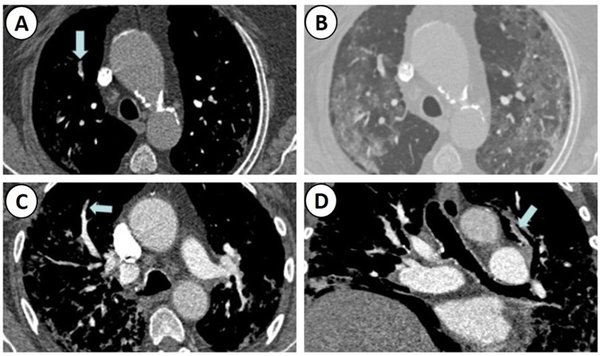-
Home
-
About JCTR
-
Gold Open Access
-
Issues
-
Editorial board
-
Author guidelines
-
Publication fees
-
Online first
-
Special issues
-
News
-
Publication ethics
-
Partners
-
Submit your manuscript
-
Submit your review report
-
Editorial Office
-

This work is licensed under a Creative Commons Attribution-NonCommercial 4.0 International License. ISSN print: 2382-6533 ISSN online: 2424-810X
Volume 9 Issue 2
Clinical prediction model for pulmonary thrombosis diagnosis in hospitalized patients with SARS-CoV-2 infection
Anabel Franco-Moreno*†, David Brown-Lavalle*, Nicolás Rodríguez-Ramírez, Candela Muñoz-Roldán, Ana Ignes Rubio-Aguilera, Maria Campos-Arenas, Nuria Muñoz-Rivas, Eva Moya-Mateo, José Manuel Ruiz-Giardín, Virginia Pardo-Guimerá, Mariano Ulla-Anes, Roberto Pedrero-Tomé, Juan Torres-Macho*, Ana Bustamante-Fermosel†on behalf of the Infanta Leonor Thrombosis Research Group.
Franco-Moreno et al. J Clin Transl Res 2023; 9(2):2
Published online: February 6, 2023
Abstract
Background and aim: We aimed to develop a clinical prediction model for pulmonary thrombosis (PT) diagnosis in hospitalized COVID-19 patients.
Methods: Non-intensive care unit hospitalized COVID-19 patients who underwent a computed tomography pulmonary angiogram (CTPA) for suspected PT were included. Demographic, clinical, analytical and radiological variables as potential factors associated with the presence of PT were selected. Multivariable Cox regression analysis to develop a score for estimating the pretest probability of PT was performed. The score was internally validated by bootstrap analysis.
Results: Among the 271 patients who underwent a CTPA, 132 patients (48.7%) had PT. Heart rate >100 bpm (OR 4.63 [95% CI 2.30–9.34]; p<0.001), respiratory rate >22 bpm (OR 5.21 [95% CI 2.00–13.54]; p<0.001), RALE score ≥4 (OR 3.24 [95% CI 1.66–6.32]; p<0.001), C-reactive protein >100 mg/L (OR 2.10 [95% CI 0.95–4.63]; p=0.067), and D-dimer >3.000 ng/mL (OR 6.86 [95% CI 3.54–13.28]; p<0.001) at the time of suspected PT were independent predictors of thrombosis. Using these variables, we constructed a nomogram (CHEDDAR score [C-reactive protein, HEart rate, D-Dimer, RALE score, and Respiratory rate]) for estimating the pretest probability of PT. The score showed a high predictive accuracy (AUC 0.877; 95% CI: 0.83−0.92). A score lower than 182 points on the nomogram confers a low probability for PT with a negative predictive value of 92%.
Conclusions: CHEDDAR score can be used to estimate the pretest probability of PT in hospitalized COVID-19 patients outside the intensive care unit.
Relevance for Patients: Developing a new clinical prediction model for PT diagnosis in COVID-19 may help in the triage of patients, and limit unnecessary exposure to radiation and the risk of nephrotoxicity due to iodinated contrast.
†These authors contributed equally to this study.

DOI: http://dx.doi.org/10.18053/jctres.09.202302.002
Author affiliation
1. Internal Medicine Department. Hospital Universitario Infanta Leonor–Virgen de la Torre, Madrid, Spain
2. Radiology Department. Hospital Universitario Infanta Leonor– Virgen de la Torre, Madrid, Spain
3. Internal Medicine Department. Hospital Universitario de Fuenlabrada, Madrid, Spain
4. EPINUT-UCM (Ref. 920325) Investigation Group, Universidad Complutense de Madrid, Madrid, Spain
5. Fundación para la Investigación e Innovación Biomédica de los Hospitales Universitarios Infanta Leonor y del Sureste, Madrid, Spain
*Corresponding author
Anabel Franco-Moreno
Department of Internal Medicine, Hospital Universitario Infanta Leonor–Virgen de la Torre. Gran Via del Este Avenue, 80, 28031, Madrid, Spain.
Email: afranco278@hotmail.com
Handling editor:
Michal Heger
Department of Pharmaceutics, Utrecht University, the Netherlands
Department of Chemistry, Utrecht University, Utrecht, the Netherlands
Department of Pathology, Erasmus Medical Center, the Netherlands
Department of Pharmaceutics, Jiaxing University Medical College, Zhejiang, China

